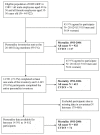Does personality explain social inequalities in mortality? The French GAZEL cohort study
- PMID: 18276626
- PMCID: PMC2650255
- DOI: 10.1093/ije/dyn021
Does personality explain social inequalities in mortality? The French GAZEL cohort study
Abstract
Background: The 'indirect-selection' hypothesis proposes that some quality of the individual, a personality characteristic or intelligence, leads to both socioeconomic position (SEP) and health. We aim to quantify the contribution of personality measures to the associations between SEP and mortality.
Methods: Of the GAZEL cohort, 14 445 participants aged 39-54 years in 1993 and followed-up over 12.7 years, completed the Bortner-Type-A-scale, the Buss-Durkee-Hostility-Inventory and the Grossarth-Maticek and Eysenck-Personality-Stress-Inventory. Indicators of SEP, such as father's social class, education, occupational grade and income, were assessed at baseline. Relative indices of inequality in Cox regression models were used to estimate associations.
Results: In age-adjusted analyses, risk of death was inversely associated with SEP among men and women. Among men, the attenuation in this association depended on the measures of SEP and was 28-29% for 'neurotic-hostility', 13-22% for 'anti-social' and 13-16% for 'CHD-prone' personality. In women, the attenuation was evident only for type-A-behaviour, by 11%. After controlling simultaneously for all personality factors that predicted mortality, associations between SEP and mortality were attenuated in men: by 34% for education, 29% for occupational position and 28% for income; but were only attenuated by 11% for income in women. For cardiovascular mortality, the corresponding percentages of reduction were 42, 31 and 44% after adjustment for 'CHD-prone' personality in men.
Conclusions: Personality measures explained some of the mortality gradients observed for measures of adult socioeconomic position in men, but had little explanatory power in women. Whether personality represents a predictor or an outcome of social circumstances needs further research.
Comment in
-
Commentary: Personality and health inequality: inconclusive evidence for an indirect hypothesis.Int J Epidemiol. 2008 Jun;37(3):602-3. doi: 10.1093/ije/dyn062. Epub 2008 Apr 3. Int J Epidemiol. 2008. PMID: 18388151 No abstract available.
References
-
- Adler NE, Boyce WT, Chesney MA, Folkman S, Syme SL. Socioeconomic inequalities in health. No easy solution. Jama. 1993 Jun–30;269(24):3140–5. - PubMed
-
- Marmot MG, Smith GD, Stansfeld S, et al. Health inequalities among British civil servants: the Whitehall II study. Lancet. 1991 Jun 8;337(8754):1387–93. - PubMed
-
- Pappas G, Queen S, Hadden W, Fisher G. The increasing disparity in mortality between socioeconomic groups in the United States, 1960 and 1986. N Engl J Med. 1993 Jul 8;329(2):103–9. - PubMed
-
- Black DS, Townsend P, Davidson N. Inequalities in health: The Black Report; The health divide. Harmondsworth; Penguin: 1988.


